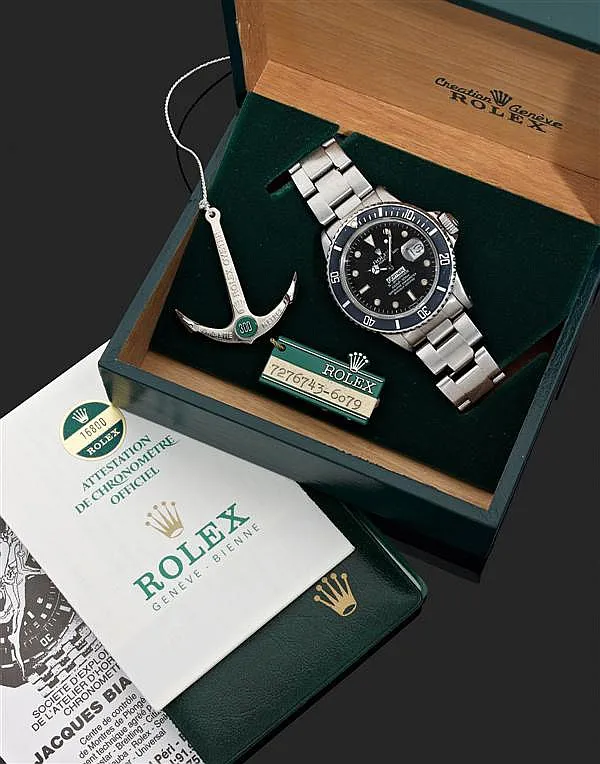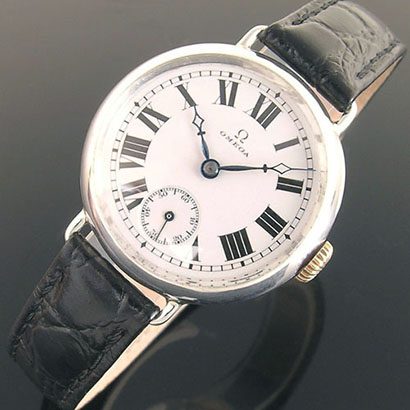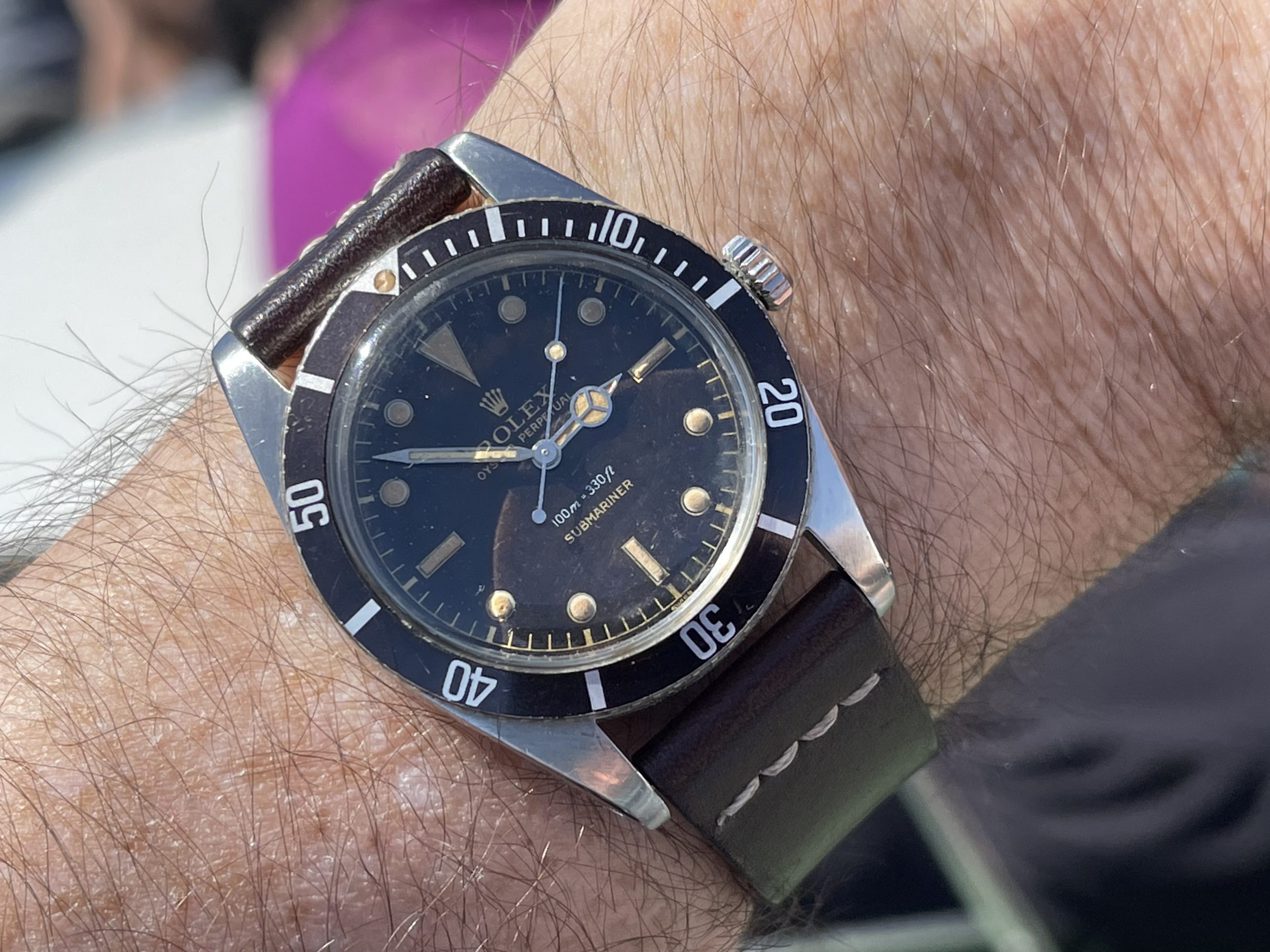THE HISTORY OF THE
ROLEX SUBMARINER
Ask anyone to describe a typical watch and the answer will probably be – a stainless steel cased bracelet watch with a luminous black dial and a rotating bezel. What they are describing is the Rolex Submariner, a watch that has been so successful it has come to typify not just a model category or a brand, but the entire concept of a ‘sports watch’.
So how did a technical tool watch, for what is still a niche sport, achieve such a dominant position in the public psyche? It comes down to simplicity, consistency, incremental improvement, and some very good marketing.

Early Beginnings
The exhausted post-war public was in desperate need of escapism. With the drama of the space race still a decade away, it was the undersea world that drew their imagination. Military technology was repurposed for leisure and scuba diving for recreation was born.
The invention of the Aqualung in 1943 allowed divers to spend longer underwater and to document their exploits. Jacques Cousteau delighted cinema audiences with his short films on subaquatic life from the mid 1940’s onwards and culminating in 1956 with a Palme d’Or at the Cannes Film Festival for his documentary ‘The Silent World’.
The divers of this pioneering period were intrepid, often reckless mavericks and the tools that they used retained a level of associated glamour, including their watches. It was in this market that Rolex launched their first dive watch, catering not just to the adventurous aquatic explorers, but also to the hordes of wannabe divers watching on the screen.

The Launch: Ref. 6200, 6204, & 6205
1953 is the date given for the launch of the Rolex Submariner, that much is agreed on. Other than that, things begin to get complicated, and with no confirmation from the brand itself, nothing is certain.
What we do know is that the 1954 Basel Watch Fair saw the public launch of the ref. 6204. This had a slim case, an A260 calibre movement and was rated to 200m, although there was no depth rating on the dial. Later the same year the ref. 6205 arrived with the same movement but only 100m water resistance. Also appearing was the thicker-cased ref. 6200 which had the A296 calibre movement and a bigger winding crown. Following the order of public release, it would seem that the 6204 was first, but other evidence suggests that this was not the case.
Rolex follow a chronological pattern to their model numbers and the movement inside the 6200 is earlier than the A260 of the other two Submariners. Additionally, the shape of the luminous triangle at 12.00 echoes that of the Explorer produced in 1953, whereas the 6204 and 6205 have the elongated triangle used from 1954 onwards. As with other models, it appears that Rolex had been producing the ref. 6200 before the 1954 formal launch, without the Submariner name, as a test piece for scuba divers. Even the name Submariner was not fixed at this stage, with Rolex registering names such as Frogman, Skin-Diver, and Dive-o-Graph. The Submariner name was not registered to the brand until the 1960s.

Model Evolution: Ref. 6536, 6538, 5508, & 5510
In true Rolex fashion, the various versions of the Submariner were tweaked and improved throughout the 1950s. The 6204 and 6205 received the new calibre 1030 and became refs. 6538 and 6536 respectively. The 6538 also received a bigger crown and distinctive ‘Submariner’ features, such as the minute markers for the first 15 minutes of the rotating bezel and the ‘Mercedes’ handset that appeared across the range. In late 1956, the case was bulked up in a similar style to the 6200, the watch receiving the designation 6538A.
The pioneering ref. 6200 received the calibre 1530 and was renamed the ref. 5510, and toward the end of the decade this movement was housed in the slimmer 6536, creating the 5508. These watches all lack the crown guards found on later Submariners and are collectively referred to as ‘James Bond’ Submariners even though only a few references appeared on Sean Connery’s wrist in the films, and none had quite the impact of Bond’s later ‘gadget’ Submariner.

Crown Guards and Dates: Ref. 5512, 5513, & 1680.
At the close of the 1950s, the Rolex Submariner assumed its characteristic modern form with the addition of crown guards to the case. As with everything Rolex, these evolved over time from an initial squared-end profile, through pointed ends, finally reaching their familiar rounded profile by the mid-1960s.
The ref. 5512, launched in 1959, was powered by the calibre 1570. This was later changed to calibre 1560, both of which were capable of chronometer-level accuracy, although this was not reflected on the dial. It wasn’t until the arrival of the ref. 5513 in 1962 with its non-chronometer 1530 movement, that the 5512 gained this wording at the 6 o’clock position of the dial.
Produced from 1962 to 1990, the 5513 is the longest surviving Submariner reference, although the dial continued to evolve with changes to the surface coating, the luminous material, and the text layout. This was the reference with the most noteworthy cinematic appearance on the wrist of Roger Moore’s James Bond.
The ‘gadget’ version with its powerful magnet and buzz-saw bezel captured the imagination of watch fans, even if the standard production model was less exciting. More importantly, the pairing of a bulky dive watch with Bond’s trademark tuxedo established Rolex in 1973 as a luxury purchase, just in time to compete with cheaper quartz alternatives.
The key development of the 1960s was the addition of the Submariner Date ref. 1680. Incorporating the distinctive ‘cyclops’ lens over the date aperture, ref. 1680 was powered by calibre 1575 and was chronometer certified from the start, as the dial text shows. The word ‘Submariner’ was initially printed in red, although this was gradually changed to white. The process of change was slow, with some red dials still being fitted to watches in the 1980s.
The ref. 1680 also ushered in the use of precious metal in this most utilitarian of watches. First in yellow gold with a black dial and bezel in 1969, and then 2 years later in a blue/yellow combination. These watches also saw the use of gold on the luminous dial markers, a feature that would eventually appear across all sports models.

Sapphires and Crowns: Ref. 16800, 16610 & 14060
With two models in the Submariner collection, evolution continued in parallel but not in tandem, with some refinements appearing on the Submariner Date first, and vice versa. The first significant step forward appeared in 1979 with the innocuous addition of a zero to the ref. 1680, creating the 16800. This represented the first use of a sapphire crystal in a Submariner, a scratch-resistant option we take for granted in a modern watch.
The crown was upgraded to the new Triplock version, first seen on the Sea-Dweller, which allowed a higher depth rating of 300m. Two years later, the 16800 was tweaked again. Although, unusually, it retained the same reference number, receiving a new calibre, the 3035. This allowed the date to be set rapidly via a second crown position rather than having to laboriously wind through the month.
The bezel was updated to be unidirectional, a feature so associated with the Submariner that people are amazed it only appeared in the early 1980s. Following the addition of gold to the Submariner Date in 1969, the 16803 saw the addition of a steel and gold (Rolesor) version.
In 1988, the changes introduced in the ref. 16800 were combined with a new movement, the widely used calibre 3135, to create the 16610. Another long-lasting member of the family, clocking up another 20 years. Over that time, other improvements appeared as technology advanced. The luminous markers changed from tritium to Luminova, and the bracelets lost their rivets making it more robust, with end-links forming a solid block, rather than just folded steel. Lug holes disappeared making bracelet changes that little bit more tricky.
While the Submariner Date line was being fettled and improved, the venerable 5513 plodded alongside awaiting its turn. This came in 1990 when it received a Triplock crown and a sapphire crystal turning it into the ref. 14060. The movement was upgraded to the new calibre 3000, still not chronometer certified. Nine years later the movement changed to calibre 3130, but was still not chronometer certified, even though this was within the movements capabilities. The words ‘Superlative Chronometer Officially Certified’ finally arrived on the dial in the late 2000s.

Cerachrom and Super-cases: Ref. 116610 & 114060
While vintage watch collectors love age and patina, Rolex does not. When it produces a tool watch, it wants the appearance and functionality to be as durable as possible. With this in mind that fade-proof, scratch-proof, ceramic bezels first made an appearance in the GMT-Master line in 2005.
In 2008, this update arrived in the Submariner line, and as with previous improvements, the Submariner Date received it first, specifically the precious metal versions. The following year ceramic bezels filtered down to the steel and gold model and two years later saw the steel model ref. 116610 elevated to this higher level.
Ceramic bezels weren’t the only change, the 40mm case was bulked up with squarer, thicker lugs, and a chunkier profile. This was matched by the use of ‘Maxi’ dials with larger lume plots and blue-tinged Chromalite material. The bracelet also received attention, featuring the new Glidelock clasp that allowed up to 5mm of tool-free adjustment.
In 2012, the No-Date Submariner received its ceramic upgrade, creating the ref. 114060. All the other refinements afforded to the ref. 116610 were included, bulking up the case and adding the new clasp. And this version of the No-Date Submariner also maintained its Superlative Chronometer status. Unlike the Submariner Date line, this model remained in steel only, stubbornly holding onto its tool watch status.

A New Silhouette, a New Movement: Ref. 116610LV, 126610 & 124060
The production of the ref. 116610LV anniversary edition with a distinctive green bezel, nicknamed the ‘Kermit’ may seem simple enough, but there are minute changes to the bezel and dial over the production years that add value and interest for those in the know. Other details are more subtle, such as the underline on a dial or the presence of a lume dot at 6 o’clock, indications of unseen changes to the radioactivity of the luminous material of the dial.
Unusually, in 2020 Rolex chose to update both the Submariner and the Submariner Date at the same time. This was to accommodate both case and movement changes. For the first time, the case diameter went over 40mm. Although this new 41mm case was larger on the wrist, the reduction in bulk around the crown guards and a more pronounced tapering of the lugs make the new case seem less chunky than the previous models.
The dials and bezels kept the same configuration and the clasp remained unchanged. Inside the cases, the new 3230 and 3235 calibres are simpler to service yet offer an increased power reserve of 70 hours. These new calibres are measured against Rolex’s new Superlative Chronometer test, stricter than the standard COSC process, it requires a maximum deviation of -2/+2 seconds per day to pass.
Submariners Place in History
Rolex is the ultimate collector’s brand, and the Submariner is possibly the ultimate collector’s reference. Outwardly simple with seemingly little changes over 70 years of production, yet there are small variances and nuances to delight the obsessive. Some details may be obvious, such as the special references created for the British Ministry of Defence, the 5517 with its fixed lug bars, and distinctive dial and bezel. Or the 5514 produced exclusively for the COMEX dive company and featuring a helium escape valve in the case band.
Some valuable features may go almost unseen, such as a ref. 16613, two-tone Submariner, where the blue dial turns out to be a wafer-thin slice of lapis lazuli. With Rolex remaining tight-lipped about its history and development decisions, such issues only add to the charm and intrigue of the brand.
Its innovative design and engineering created a new standard for diving watches, and it has become the benchmark against which all other dive watches are compared. The Submariner has also become a cultural symbol, making uncountable guest appearances in movies and on the wrists of the rich and famous around the world. No wonder it’s the most recognised watch in the world and the superstar darling of the Rolex collection.
The Rolex Submariner remains an enduring, timeless example of first-class industrial design and a watch that will forever be the benchmark by which all others are measured. So, are you ready to add one to your collection?
If so, or if you just want to browse with lustful eyes, head over to our website to see the range of vintage Submariners we have in stock. We have a stunning collection of pieces, from the mid-50s to the early 90s, just beware that you may fall head over heels in love instantly.
To get regular news and updates from Vintage Gold Watches sign up to our newsletter today.




